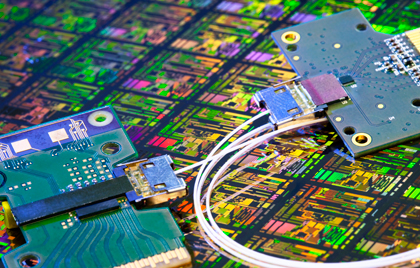Intel's 50Gbps Laser Light Beams Are the Future
Someday in the future, we may look back on the technology we're using today and laugh that we were using electrons to carry data in and around computers.
Intel Corporation this week announced a research prototype representing the world's first silicon-based optical data connection with integrated lasers. The link can move data over longer distances and many times faster than today's copper technology; up to 50 gigabits of data per second. This is the equivalent of an entire HD movie being transmitted each second.
The transmitter chip is composed of four such lasers, whose light beams each travel into an optical modulator that encodes data onto them at 12.5Gbps. The four beams are then combined and output to a single optical fiber for a total data rate of 50Gbps. At the other end of the link, the receiver chip separates the four optical beams and directs them into photo detectors, which convert data back into electrical signals.
While telecommunications and other applications already use lasers to transmit information, current technologies are too expensive and bulky to be used for PC applications.
Today computer components are connected to each other using copper cables or traces on circuit boards. Due to the signal degradation that comes with using metals such as copper to transmit data, these cables have a limited maximum length. This limits the design of computers, forcing processors, memory and other components to be placed just inches from each other.
The technology, called silicon photonics, will have far reaching applications. For example, at these data rates one transmit far higher-definition video in a teleconference than what our 1080p sets can display. Silicon photonics will also enable datacenters to be more flexible in location and setup.
"This achievement of the world's first 50Gbps silicon photonics link with integrated hybrid silicon lasers marks a significant achievement in our long term vision of ‘siliconizing' photonics and bringing high bandwidth, low cost optical communications in and around future PCs, servers, and consumer devices" Justin Rattner, Intel chief technology officer and director of Intel Labs, said.
Get Tom's Hardware's best news and in-depth reviews, straight to your inbox.
-
treefrog07 Embedded fiber-optics in my motherboard.....So, my 2020 motherboard will display a LASER light show without my having those blue CCFL tubes? But seriously, when I looked at all the wires connecting all my peripherals, I was thinking that wire management will surely be easier - smaller, thinner bundles.Reply -
frye "Someday in the future, we may look back on the technology we're using today and laugh that we were using electrons to carry data in and around computers."Reply
And then we'll laugh again when we switch back to using electrons. Except this time, we'll be using individual electrons to carry binary data. Up spin can equal 0 and down spin can equal 1. -
quiky87 I might be off but 50Gbits per second is 5GB per second an HD movie is (for a single layer BD-Rom 25GB so it would be every 5 seconds or 10 seconds for a 50GB BD.Reply

